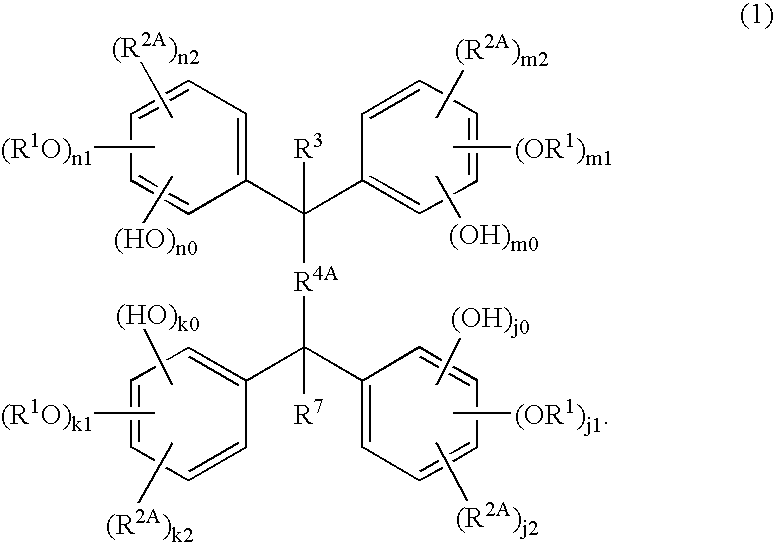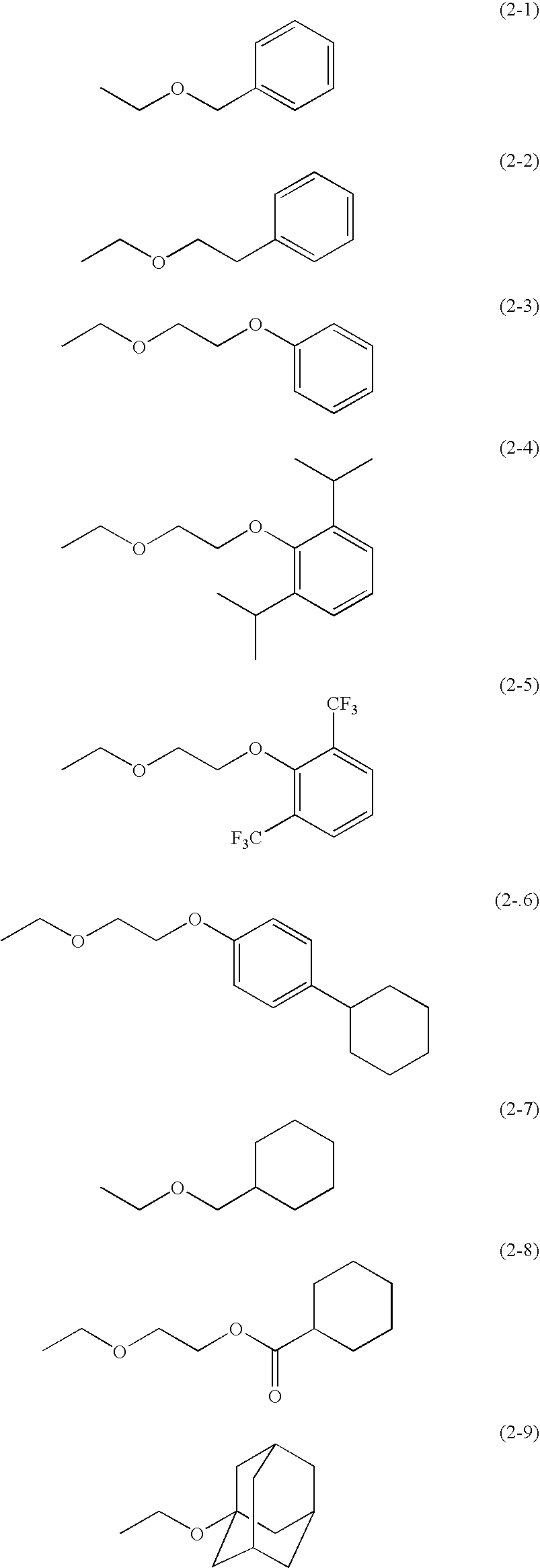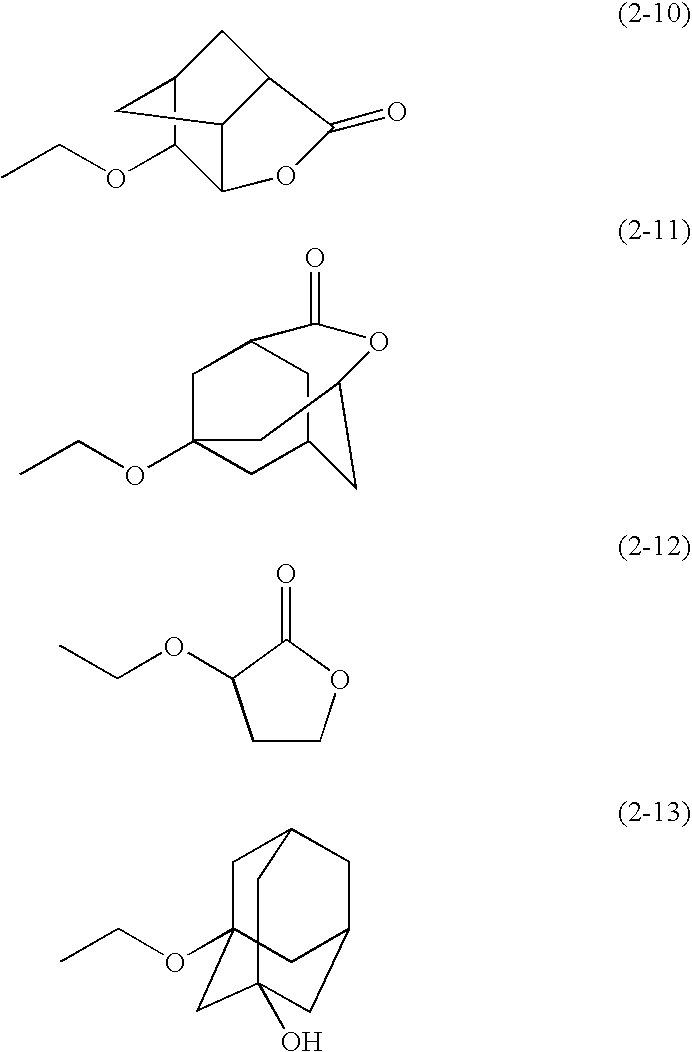Compound for Resist and Radiation-Sensitive Composition
a technology of resist and radiation-sensitive composition, which is applied in the direction of photosensitive materials, instruments, photomechanical equipment, etc., can solve the problems of reducing the product yield, affecting the transistor characteristics, and difficult to control the pattern dimension, etc., and achieves high heat resistance, high sensitivity, and high resolution
- Summary
- Abstract
- Description
- Claims
- Application Information
AI Technical Summary
Benefits of technology
Problems solved by technology
Method used
Image
Examples
synthesis example 1
Synthesis of tetrakis(2,5-xylenol)-2,6-naphthalenedialdehyde (Compound 101)
[0189]A mixture of 195 g (1.6 mol) of 2,5-xylenol (Kanto Chemical Co., Inc.) and 20.0 g (0.1 mol) of 2,6-naphthalenedialdehyde (synthesized by the method described in JP 2003-155259A) was made into a solution under heating to about 60° C. After adding 0.2 ml of sulfuric acid (Kanto Chemical Co., Inc.) and 1.6 ml of 3-mercaptopropionic acid (Kanto Chemical Co., Inc.) to the solution, the reaction was allowed to proceed under stirring. After confirming 100% conversion by a liquid chromatography, 100 ml of toluene (Kanto Chemical Co., Inc.) was added. The solid precipitated by cooling was filtered under reduced pressure, washed with a warm water of 60° C. under stirring, and purified by a silica gel column chromatography, to obtain the title compound. The structure of the compound was determined by elemental analysis and 1H-NMR measurement (400 MHz, d-DMSO, TMS internal standard). The results are shown in Tables...
synthesis examples 2-8
Synthesis of Compounds 102 to 108
[0190]Each title compound was synthesized in the same manner as in Synthesis Example 1 except for changing 2,5-xylenol and 2,6-naphthalenedialdehyde to the compounds listed in Table 1.
The structure of each compound was determined by elemental analysis and 1H-NMR measurement (400 MHz, d-DMSO, TMS internal standard). The results are shown in Tables 2 and 3.
[0191]
TABLE 1(Synthesis of Polyphenol A)SynthesisCompoundaromatic polyketone or aromaticCompound having phenolicExamplesNos.polyaldehydehydroxyl group11012,6-naphthalenedialdehyde*12,5-xylenol21022,6-naphthalenedialdehyde*12,3,6-trimethylphenol31032,6-naphthalenedialdehyde*1thymol41042,7-naphthalenedialdehyde*22,5-xylenol51052,7-naphthalenedialdehyde*22,3,6-trimethylphenol6106m-terphenyldialdehyde*32,5-xylenol7107p-terphenyldialdehyde*42,5-xylenol81081,3,5-benzenetricarbaldehyde*52,3,6-trimethylphenol*1Synthesized by the method described in JP 2003-155259A.*2Synthesized in the same manner as in *1 ex...
synthesis example 9
Synthesis of Compound 109
[0192]A solution of 0.6 g (0.9 mmol) of Compound 101, 5 ml of dry acetone, 0.18 g of pyridinium p-toluenesulfonate, and 0.2 g (2.8 mmol)of ethyl vinyl ether was stirred at room temperature for 24 h. The reaction product solution was purified by a silica gel column chromatography (elute: ethyl acetate / hexane=1 / 2), to obtain the title compound (compound B). The structure of the compound was determined by elemental analysis and 1H-NMR measurement (400 MHz, d-DMSO, TMS internal standard). The results are shown in Tables 5 and 6.
PUM
| Property | Measurement | Unit |
|---|---|---|
| Temperature | aaaaa | aaaaa |
| Temperature | aaaaa | aaaaa |
| Fraction | aaaaa | aaaaa |
Abstract
Description
Claims
Application Information
 Login to View More
Login to View More - R&D
- Intellectual Property
- Life Sciences
- Materials
- Tech Scout
- Unparalleled Data Quality
- Higher Quality Content
- 60% Fewer Hallucinations
Browse by: Latest US Patents, China's latest patents, Technical Efficacy Thesaurus, Application Domain, Technology Topic, Popular Technical Reports.
© 2025 PatSnap. All rights reserved.Legal|Privacy policy|Modern Slavery Act Transparency Statement|Sitemap|About US| Contact US: help@patsnap.com



